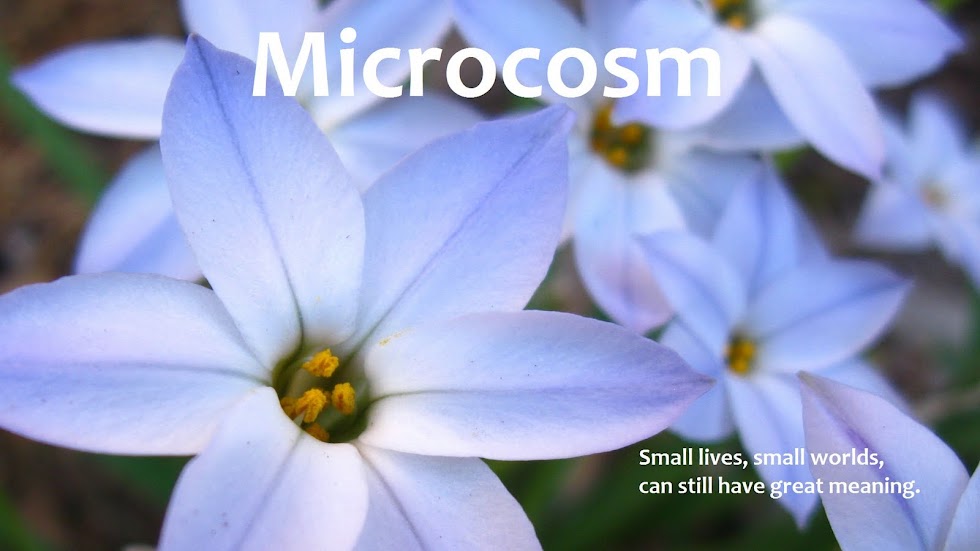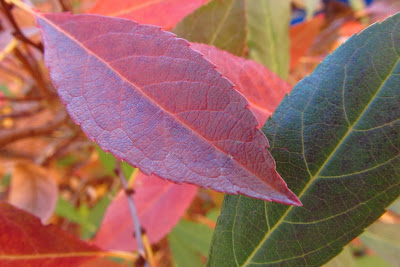or In Which We Celebrate Individuality, Whether We Want To or Not
The furnace really was more important than the Western sand cherry bush (
Prunus besseyii). I thought so last February when
the temperature dropped to -7°F (a 40-year low) and the furnace broke down, and still think so now. The repairman did a wonderful, careful job despite vicious wind and sub-zero temperatures and was cheerful the whole time. Even so, the part of me that likes to ponder the general cussedness of things wondered what law of nature decrees that with three feet of clear space and a brick path to stand on, a workman must nevertheless step on the plants. The Sad Sand Cherry, poor thing, was apparently in the way, and after its little adventure with big boots, it took a while to recover. Three seasons later it's still missing half the branches on one side and looks pretty lopsided. It didn't grow much over the summer, but it lived, and that's saying something, in an Eeyore-ish sort of way. Now, autumn has come to it in spots.
 |
| Autumn or chicken pox? It can be so hard to tell. |
Meanwhile, across the path closer to the patio is another cherry planted at the same time two years ago. It gets quite a bit of shade from one of the desert olives (
Forestiera neomexicana) and isn't growing quickly, but it's thickly leaved and branched and looks strong and healthy. It is now officially taller than the salad burnet, and it produced one (1) cherry this year. I was so proud. The Slow Sand Cherry is
fixin' to enjoy some autumn, but maybe not all at once. It's getting there, though, one easy-going, leisurely leaf at a time.
The other cherry near the patio is what I expected all of them to be—about three and a half feet tall and wide, more or less nicely shaped, thickly leaved, full of cherries, and generally well-behaved. It's been in the ground for four years and has officially graduated to drought tolerance. (Now there I
am proud.) The Teacher's Pet Sand Cherry is still mostly green, but it's beginning to change colors ever so delicately and attractively. With impeccable timing, it should be at its reddest precisely when its neighboring olive tree is at its most golden-green.*
And then there's the Big Hairy Monster in the far corner. I love that cherry. It's about six feet tall and wide, way too large to be convenient, half again the size I thought it would be. I end up whacking it back hard twice a year, and it still blocks the path. But boy, is it gorgeous. If I remember correctly, it was one of the first things I planted in the garden, if not
the first. Back then I nurtured things properly, rather than just plopping them in the ground and wishing them luck. I watered regularly and fertilized carefully and worried and fussed, and as a reward I have a healthy, happy monster on my hands that's really way too big. Two weeks ago it looked like this:
But now it looks like this:
For the record—because you certainly can't tell from looking—the point of planting four bushes all alike in the four quadrants of the garden was to enjoy a little symmetry. Not uptight symmetry, not super-pruned rigid sameness or anything, just a general sense of kinship between one part of the garden and another. The idea was to create a single, overall effect, especially in the fall, when I had hoped for a garden full of rust-red leaves. All at once. That is to say, all at the same time.
I don't really expect the two youngest bushes to be the same size yet as the older ones. I understand that the Sad Sand Cherry has had a hard time. And boy howdy—micro-climates, are they everywhere or what? Not one of the bushes has the same growing conditions as the others, even though they're only a few feet apart. Genes can sure be different from one plant to the next; colors do vary from year to year. As personal problems go, having your shrubbery out of sync ranks so low that it doesn't even make the list. And yet—
I'm just going to mutter
"Vive la différence" for a while until I believe it.
__________________________
* As a fine example of cussedness, this exemplary sand cherry is the one of which I am least fond, for no apparent reason.












































